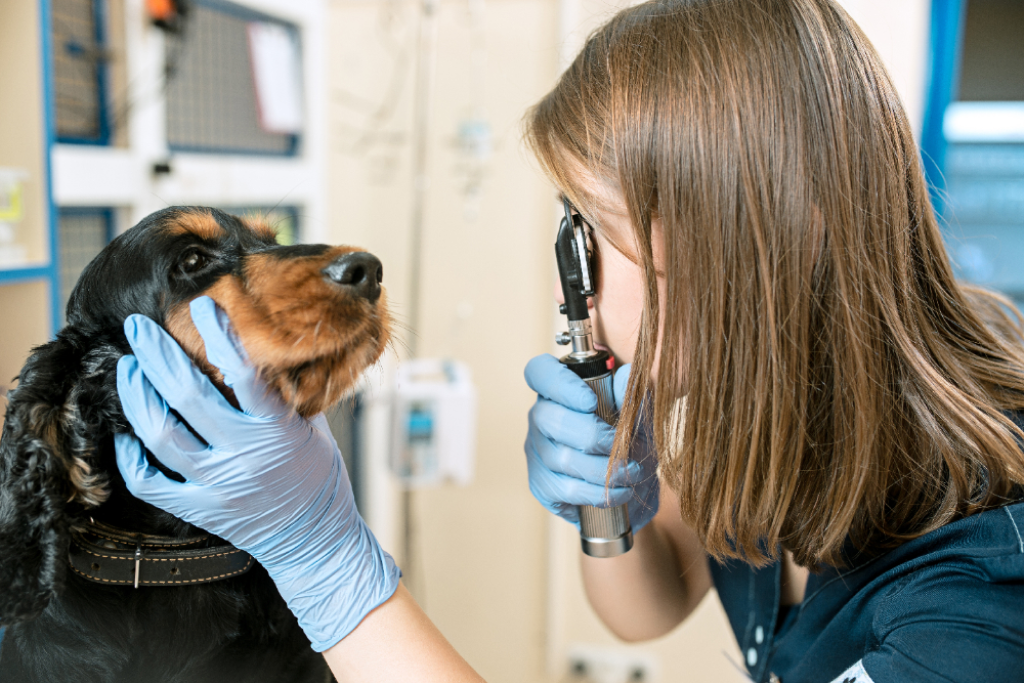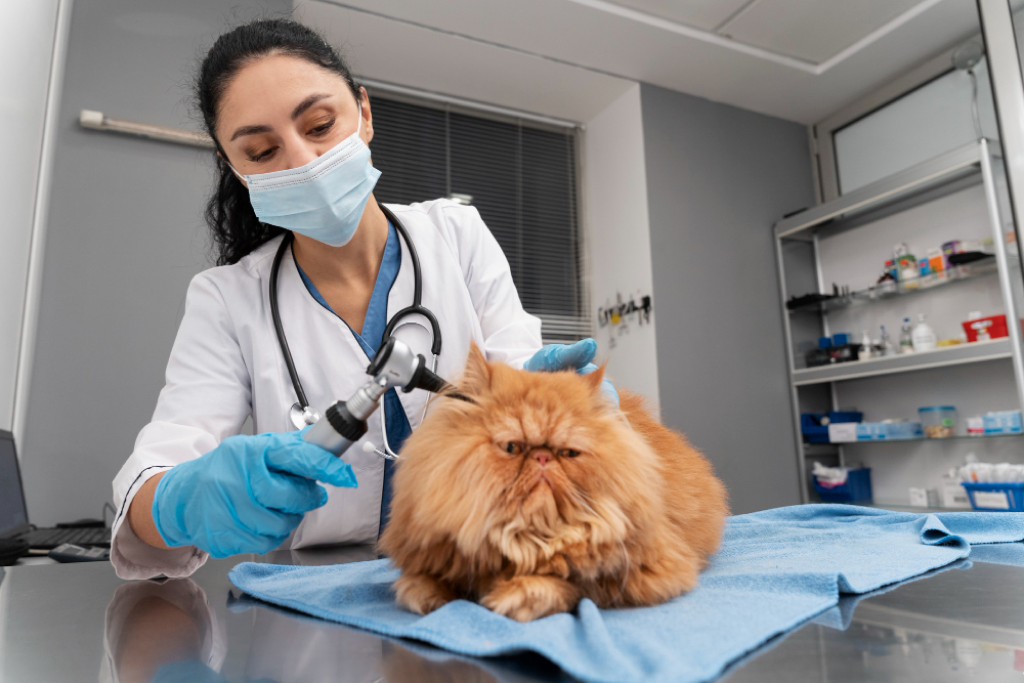Learn to spot the obvious signs today
Dental disease is common in cats and dogs. If left untreated it can cause serious issues for your pet’s health beyond just their mouth. There are a number of signs that your pet could have an issue with their teeth or gums, we’ve detailed them all in this blog to help you be more vigilant around their oral health. If you notice any of the signs mentioned, book an appointment at Knutsford Vets today.
Bad Breath
Bad breath in animals is usually caused by a build-up of bacteria and just like in humans, it can be a sign of poor dental health amongst other possible causes. You can help prevent bad breath and begin a routine of inspecting your pet’s mouth for plaque build-up. Once they are comfortable with their teeth being inspected, you can begin a brushing routine. Find out more about how to brush your dog’s teeth in this blog or book a nurse appointment for more help.
Tartar
Tartar build-up starts as a yellowing of the teeth from around the gums caused by plaque. Eventually the build-up of plaque will grow darker and cause reddening of the gums where the tooth joins the gum. As the tartar build up gets worse it will get darker and eventually it will cause dental disease. Luckily you can reduce tartar build-up significantly by brushing your pet’s teeth regularly.
Red or inflamed gums
Red or inflamed gums can be caused by a number of conditions relating to poor dental hygiene. The most common is gingivitis which occurs if your animal notices significant plaque and tartar build-up. Red gums may also indicate an infection which may have caused an abscess affecting the root of the infected tooth. Abscesses are extremely painful and should be treated straight away with antibiotics.
Swelling in the face
Swelling, affecting the face around the mouth, could be caused by an infection in the mouth or an abscess that is deep within the gums or jaw. If it is caused by an abscess it will usually be painful and may be accompanied by other symptoms such inflamed gums or signs of pain.
Wobbly or broken teeth
If you don’t check your pet’s teeth regularly you might not notice any of the signs above until it’s too late and their teeth have already become damaged. Dental disease can weaken the gums that hold our pet’s teeth in place causing them to become wobbly or even fall out. It can also cause the teeth to become brittle, leaving them susceptible to damage or breaking. If you notice either of these signs you should book an appointment immediately.
Heart Disease
It may seem the heart and teeth are completely unrelated, but there is strong evidence to suggest a link between dental disease and heart disease in pets. The risk of developing cardiopulmonary diseases like endocarditis is six times higher in dogs with moderate to severe dental disease according to the World Small Animal Veterinary Association (WSAVA).
It’s also common that infected heart valves will contain the same cultured bacteria that can be found in the mouth. Dental hygiene is not only important for your pet’s teeth, but it can also help prevent life-threatening issues.
Only eating with one side of their mouth
If you notice your pet is favouring one side of their mouth when eating and you haven’t noticed this before it could be a sign of pain. You may also notice your pet dropping food out of their mouth as a result of this behaviour as they struggle to avoid biting or chewing with a particular part of their mouth.
Eating Less and a preference for soft food
If your pet is avoiding eating hard foods such as dog or cat biscuits, this could indicate pain affecting their teeth or mouth. Although a loss of appetite could indicate other health issues, it could be another sign of toothache. You should consult a vet if you notice your pet’s eating habits change for longer than a couple of days and you should be vigilant to any other potential signs of illness.
Pawing at the mouth
Pawing at the mouth is a common sign of pain affecting the teeth, gums, lips or tongue in dogs. It could be caused by any number of things, such as toothache, a cut or even an insect sting. If it persists for longer than a day or is very severe, you should seek veterinary care straight away so that we can get to the bottom of the cause.
Gingivitis
Plaque that exists on your pet’s teeth contains all different kinds of bacteria. These bacteria can trigger a response from our pet’s immune system as it seeks to eradicate the bacteria. Although it is often successful in removing harmful bacteria, this response can cause damage to the gum tissue that holds your pet’s teeth in place.
This response is known as gingivitis, a condition which is actually more harmful to teeth than the bacteria that it eradicates. It causes an area of the gum around the teeth to become red and inflamed. You can counteract this inflammation by simply maintaining good dental hygiene that removes the bacteria before any problems occur.
Tooth Decay
If your pet has unhealthy teeth then it’s likely that plaque will progress into tartar build-up. This can lead to pockets forming around the roots of the teeth as a result of horizontal or vertical bone loss. This can be painful for pets and can lead to a severe loosening of the teeth that will eventually fall out. Often the only remedy is to remove the affected teeth completely.
Prevention is always the best cure for tooth decay as the effects are irreversible, so adopt a tooth brushing routine that eradicates plaque and protects your pet’s teeth.
Weight loss
Our pets’ can be extremely good at hiding any illnesses, pain or weakness thanks to their ancestors’ survival instincts in the wild. This can make it difficult to spot signs of dental disease if you don’t regularly inspect your pet’s mouth and as a result one of the first signs might be weight loss due to pain whilst eating.
This is just another reason why regularly checking your pet’s weight is an important part of maintaining their overall health. It can be especially important if your cat or dog shares their feeding area with other pets because you wouldn’t necessarily notice if they had left some food in their bowl.
Diabetes Complications
Diabetes and dental disease in pets can work together to form a vicious cycle. Although it’s not obvious whether dental disease increases the risk of diabetes or vice versa, the occurrence of dental disease is far more common in diabetic dogs.
Even more concerning is the fact that dental disease can make the symptoms of diabetes worse and likewise, diabetes can make the effects of dental disease worse. With this in mind, it’s important that you adopt a strict dental hygiene routine for diabetic pets to help manage the effect it can have on their teeth.
Chronic Pain
Chronic pain is often undetectable in pets due to their ability to hide any signs of discomfort – a survival instinct passed down from their wild ancestors. Dental disease can cause pain that develops slowly and gradually gets worse. As a result, it can lead to many years of suffering. This can have a severe and unseen impact on your pet’s quality of life, to a point where it will impact what they can eat and can cause them to lose their appetite all together.
Jaw fractures
As dental disease takes hold it weakens the teeth. If it goes unnoticed for a long period of time this weakness can spread to the bones in the jaw which become brittle. This can lead to fractures in the jaw occurring from innocuous seeming circumstances such as whilst playing.
These instances can be even more common in smaller dogs that already have very fragile bones.
Even more alarming is the fact that the damage that happens to the bone becomes harder to repair because the bone itself becomes weaker and more brittle as a result. The only way to prevent such cases happening is to begin checking your pet’s teeth so that you can identify any issues early.
How to avoid dental disease
With dental disease prevention is always more effective than the cure. It’s important that dental hygiene becomes part of your pet’s daily routine. There are a wide range of products that can help combat the early stages of plaque build-up, whilst spending time getting your pet used to brushing is important.
Reduce the risk of dental disease by following these 4 steps and don’t be afraid to reach out to your vet for expert advice.
- Get your pet used to their teeth being touched so that you can check for plaque or tartar build-up
- Adopt a brushing routine – follow this guide for help
- Use products that will help reduce plaque such as plaque powder or treats
- If you notice any symptoms of dental disease visit the vet immediately
- More advice from Knutsford Vets Surgery





